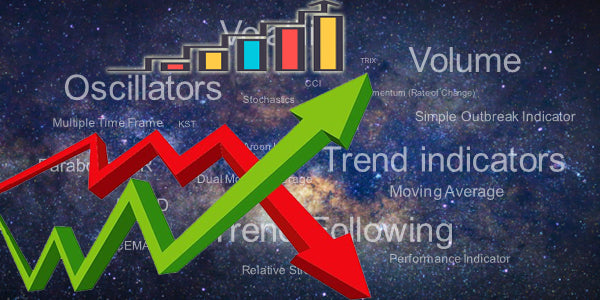Indicators and Oscillators

Indicators and Oscillators

Indicators are statistics used to measure current conditions as well as predict financial or economic trends. Indicators for technical analysis aim to estimate the prices that will occur in the future by making calculations based on the price or volume of securities.
Financial markets are the most objective method for your investment decisions to be based on data. It is recommended that you decide according to what and when to open a position, using various technical analysis tools through indicators. The buying and selling conditions of the indicator may change according to the state of the chart. For this reason, it is inevitable to know the properties of the indicator being studied and to determine the input and output points with the support of oscillators if necessary.
Indicator-based analysis
Many traders use indicator-based analysis to help them decide which trades to take and where to enter and exit them. Indicators are used as an additional source of information that strengthens or weakens possibilities when interpreting existing data. Indicators are used to analyze the trends, acceleration, volatility, and other possible movements of the indicators. Indicators are calculations that allow you to create a chart based on price or volume data, with the simplest recipe.
Some indicators are set up to give clear buying and selling signals. Some parameters are interpreted according to a specific strategy. Most traders using indicators use multiple indicators at the same time. The goal is to reach a combination of signals through different indicators that are correlated with each other.

Most Used Indicators:
- Moving average (MA)
- Exponential moving average (EMA)
- Stochastic oscillator
- Moving average convergence divergence (MACD)
- Bollinger bands
- Relative strength index (RSI)
- Fibonacci retracement
- Ichimoku cloud
What Is Indicator Based Trading?
An indicator manipulates price data using a mathematical formula. Certain traders favor technical analysis indicators because they believe these indicators allow them to predict what the market will do and where it will go with precision—if you learn to use the indicators effectively.

Leading and lagging indicators
Leading indicators indicate that an indicator that manages to give a preliminary signal can position you before a potential move in the market. Leading indicators precede price movements and have predictive importance. However, leading indicators are often misleading. Traders often interpret multiple leading indicators together. Lagging indicators are appear later. They act as a confirmation instead of guessing. Lagging indicators are often used as verification tools.
Indicators are divided into four groups in terms of structure:
- Momentum Based Indicators
- RSI, CCI,- Stoch RSI, - Ultimate Oscillator, - Aaron
- Trend Following Indicators
- Moving Averagesi, - MACD, - Parabolic SAR
- Volatility Indicators
- Bollinger Bands, - Average True Range
- Volume and Money Entry-Exit Indicators
- Accumulation / Distribution, - Chaikin Money Flow, - Demand Index - On Balance Volume (OBV), - Money Flow Index
Indicators do not question causes and consequences. Using the indicators is the expectation that the price movement can always produce the same result under certain conditions. However, the indicators do not give 100% correct results. In short, they do not show the future. Indicators allow you to see the price or volume movement that has occurred. It is an effort to obtain results from this data.
What are Market Indicators?
Market indicators are indicators created to predict market movements, interpret stock or financial index data and guide investors. Market indicators are at a lower level of technical indicators.

What is Oscillators
They are indicators that determine whether the market is in overbought or overbought territory. It is drawn below the price chart. When the oscillator reaches the upper end, it is in the overbought zone, and when it reaches the lower back, it is in the oversold zone. According to another definition, in non-trending markets, when prices move in a horizontal band, indicators that detect correction levels within the trend are called oscillators. Traders use the trend indicator to discover short-term overbought or oversold conditions.
Oscillators are popular and widely used because they are considered leading and lagging indicators that can signal a possible trend change that has not yet begun. This type of indicator oscillates between two boundaries above and below the midpoint, and this value helps measure the strength and momentum of a trend.
What is the Difference Between Oscillators and Indicators?
There are differences between the two concepts. Indicators are making predictions by modeling the price charts of investment instruments formed in the past. Oscillators are to conclude the changes between the purchase and sale values of the prices in investment instruments.
Types Of Oscillator:
- Relative Strength Index
- Stochastic Oscillator
- Real Strength Index
- Ultimate Oscillator
How Oscillators Work
Oscillators are typically used in conjunction with other technical analysis indicators to make trading decisions. Analysts find oscillators most advantageous when they cannot easily find a clear trend in a company's stock price, for example, when a stock trades horizontally or sideways.
As long as the underlying security price remains within the specified range, the signals remain valid. However, when a price break occurs, the signals can be misleading. In technical analysis, investors find oscillators to be one of the most important technical tools to understand. Still, analysts also find other technical tools helpful in enhancing their trading, such as chart reading skills and technical indicators.
Benefits Of Oscillators
Technical analysts consider oscillators to be more suitable for ancillary markets and find them more effective when used in conjunction with a technical indicator that defines the market based on a trend or range.
Oscillators also signal overbought or overbought (meaning the price is meaninglessly high or low) for a market, which could mean a reversal in the trend. This information can be used to determine when you can close open positions.
Oscillators work best in volatile markets because they can show overbought or oversold conditions too soon in trending markets. Common things to look for are midpoint intersection, approaching the maximum or minimum value, and regular or hidden dissociation.
What is Overbought & Oversold
The Stochastic Oscillator is an acceleration indicator that compares the closing prices of securities with the price range within a specified time frame. An oscillator tied to the main indicator allows investors to see when an asset is overbought and sold. Imagine that the fixed values on a graph can range from 0 to 100, that is, within a limited range. The threshold setting for overbought and oversold on MetaTrader4 and many platforms is above 80 and below 20. Below 20 means the price is near the lowest level, while over 80 means the price is near the highest. However, these settings can be changed according to the investor's preference.



